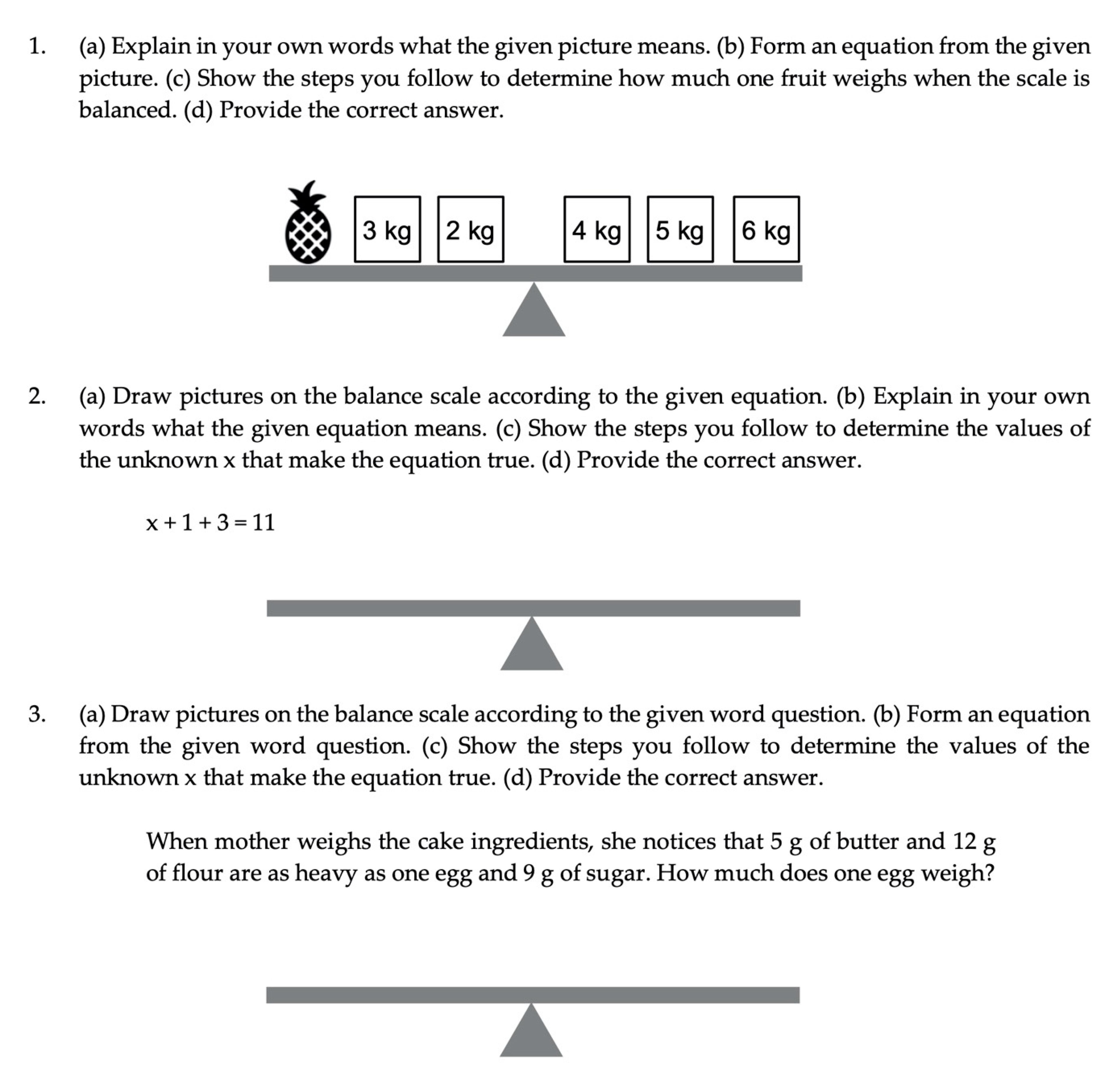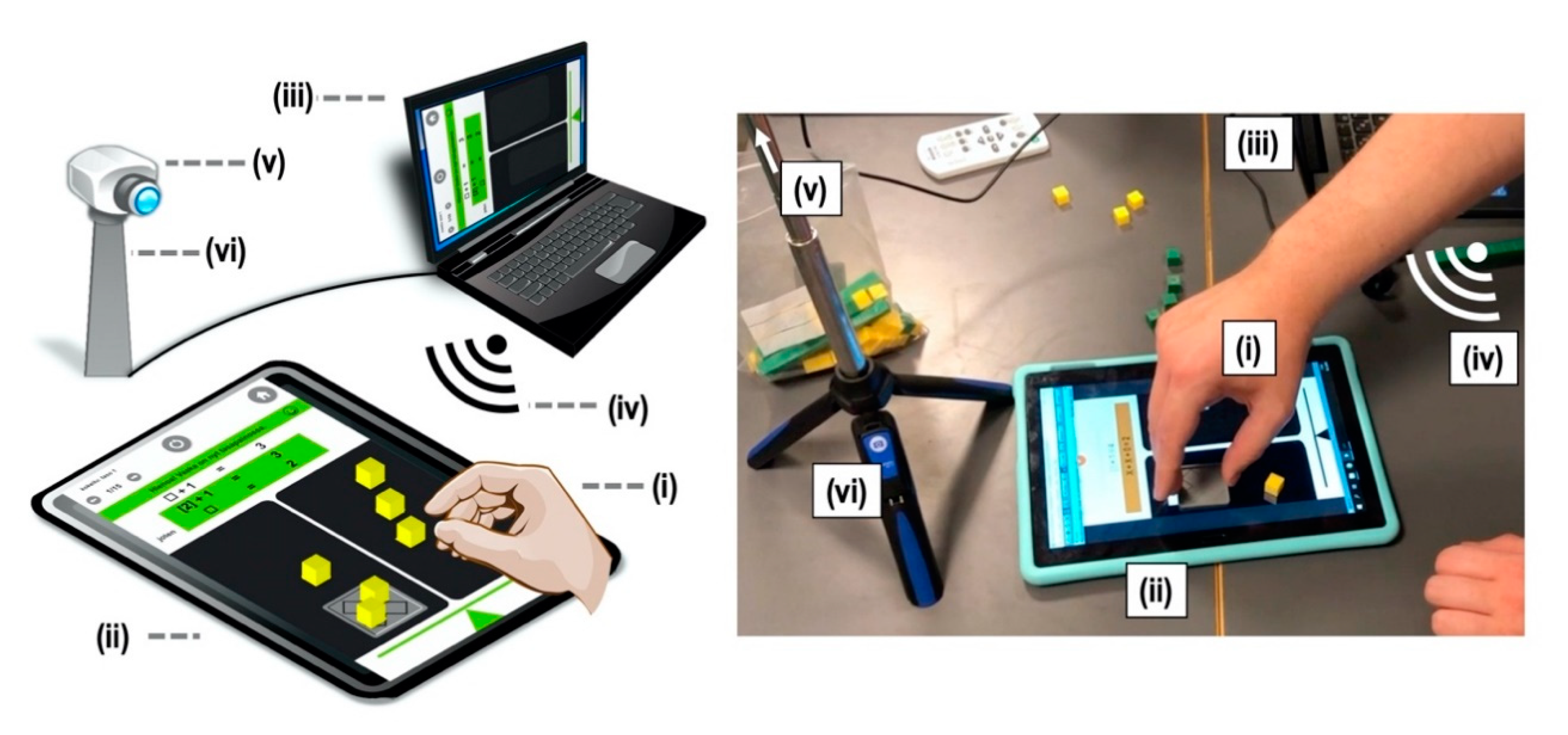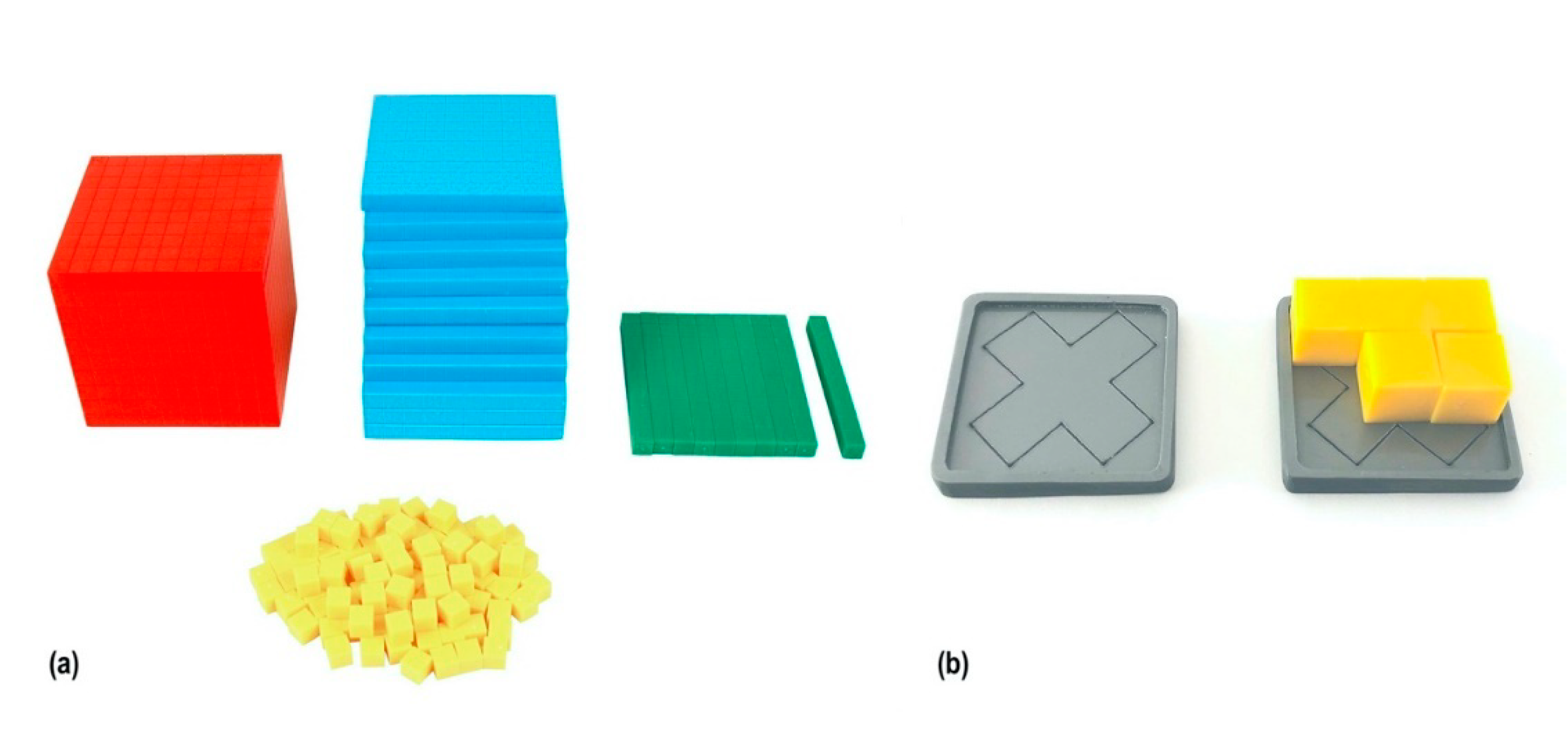The Potentials of Tangible Technologies for Learning Linear Equations
Abstract
:1. Introduction
- What are the impacts of the proposed manipulative on students’ learning achievement?
- Does the proposed manipulative promote students’ learning in terms of understanding equation-solving concepts, languaging, and learning through discovery and social interaction, and, if so, then how?
- How do students perceive the usability of the proposed manipulative, and how well can they use it?
2. Theoretical Background
2.1. Equation Solving
2.2. Multimodal Mathematics
2.3. Tangible Technologies for Learning
2.4. Learning through Discovery and Social Interaction
2.5. The Finnish National Core Curriculum for Basic Education (NCC) 2014
3. Design, Development, and Implementation of the X-is Tangible Manipulative (TM)
3.1. Design Objectives and Principles
- DP 1.
- DP 2.
- Be in agreement with school curriculum: Finnish teachers of basic education plan their teaching based on the Finnish NCC. Therefore, a manipulative should conform to the NCC [56] to ensure its use in classrooms.
- DP 3.
- DP 4.
- DP 5.
- DP 6.
- Be suitable for diverse learners: A manipulative should provide differentiation of instruction based on students’ diversity [56] by assisting students who are at different achievement levels in learning equation solving.
- DP 7.
- Be easy to use: An easy-to-use manipulative is more likely to be adopted in classrooms. According to our empirical research [57,58], the ease of use of a TM can be optimised through the following:
- DP 7.1.
- Single point of interaction: The input and output of a TM should occur at the same point of interaction (i.e., a ‘co-located’ design [16]) to allow students to manipulate physical objects and look at a GUI without moving their sight back and forth.
- DP 7.2.
- Use of base-10 blocks as physical objects: Base-10 blocks are widely used manipulatives for learning of number sense, place value, and operation in various countries, including Finland. All the schools that participated in our previous studies [57,58] were familiar with the base-10 system. Thus, it can be conveniently used as physical manipulative objects to reduce students’ cognitive friction [59].
- DP 7.3.
- Straightforward user interface (UI): A simple UI enables teachers and students to use it with ease. Consequently, it saves time spent on its utilisation and prevents frustration.
- DP 8.
- Be feasible for classroom and school practice: A manipulative design that takes the following factors related to classroom and school practice into account is more likely to be adopted and used in classrooms:
- DP 8.1.
- DP 8.2.
- Practicality and convenience: According to our research [57,58] and that of others [60,61,62], time constraints, manipulative preparation and organisation issues, and limited storage space are among the possible hindrances to manipulative acquisition and utilisation. Based on our concept evaluation [58], the following properties can increase the practicality and convenience of manipulatives:
- A straightforward manipulative requires less time and effort spent on preparation, instruction, operation, and clean-up.
- A portable manipulative can be easily circulated in the classroom and around the school.
- A proper size and sensible number of parts allows for easy storage and prevents pieces from becoming lost or mixed up.
- A manipulative should be compatible with Android tablets or iPads due to (1) the increasing number of these devices in Finnish schools as a result of the digitalisation of learning environments that is encouraged by the current NCC [56] and (2) the growing number of Finnish teachers and students who have these devices.
- DP 8.3.
- DP 8.4.
- Utility: Our concept evaluation [58] has revealed that high utility is one of the teachers’ criteria for acquiring manipulatives. A manipulative that can be used for different grade levels or content areas is preferable. Its compatibility with schools’ existing infrastructure and equipment is also important.
3.2. The Implemented Architecture
3.3. Object Tracking Alternatives
3.4. Features and Interactions
3.5. Prototyping
4. Classroom Evaluation of X-is
4.1. Participants
4.2. Research Design and Procedures
- To determine the impacts of the languaging-based instruction (with or without X-is) on students’ learning achievement based on the results from paper-based test and thinking aloud sessions.
- To discover whether and how X-is promoted students’ learning (i.e., their understanding of equation-solving concepts, languaging, and learning through discovery and social interaction) based on the results from class interventions, student and teacher questionnaires and interviews, and thinking aloud sessions.
- To investigate how students perceived the usability of X-is and how well they could use it based on the results from class interventions, student questionnaire and interview, and thinking aloud sessions.
4.3. Data Collection and Analysis
4.3.1. Class Intervention
4.3.2. Students’ Paper-Based Tests
4.3.3. Students’ Thinking Aloud
4.3.4. Student Questionnaires and Interviews
4.3.5. Teacher Questionnaires and Interviews
- Students’ understanding of equation-solving concepts (three items; X-is: α = 0.90, paper-and-pencil instruction: α = 0.90),
- Students’ languaging (five items; X-is: α = 0.71, paper-and-pencil instruction: α = 0.67), and
- Students’ learning through discovery and social interaction (three items; X-is: α = 0.53, paper-and-pencil instruction: α = 0.81).
5. Results and Discussion
5.1. Learning Achievement
5.1.1. Students’ Paper-Based Tests
5.1.2. Students’ Thinking Aloud Sessions
5.1.3. Discussion of Learning Achievement
5.2. Learning Support
5.2.1. Class Intervention
5.2.2. Student Questionnaires, Interviews, and Thinking Aloud Sessions
5.2.3. Teacher Questionnaires and Interviews
“The manipulative is very action based and visual. I would say that these help students to explain [the concept] to peers. When students have solved it with their hands, it is easier for them to talk about [the process]. Textbooks and e-textbooks are also very visual, full of pictures and videos. However, textbook exercises usually urge students to move forward too fast instead of talking about the current exercise.”(Lower secondary school mathematics teacher)
“When students got stuck, they could not get through on their own with the worksheet. Whatever weights students added on the scale [image on the worksheet], the scale wouldn’t move. So students might proceed with the wrong solution. But with the manipulative, students could add and remove blocks and got feedback from the manipulative.”
“When working with manipulatives, there are steps that the students can easily talk about. One student can tell another one, for example, ‘First, put it there. Do you notice how the scale moves?’ But when working with a textbook where there is, for example, x + 2 = 6, there is not much to discuss, only x = 6 − 2. It is difficult for students to invent what to talk about.”(Special education teacher)
“When everything is digital, students may perceive it as a game. So, they will act like [they do when] playing games [and] just rush to do everything. A good example is when I asked students to learn how to draw points in GeoGebra [an interactive mathematics application]. Some students just kept on clicking [their mouse], so that their screen was full of points. Their minds were in a racing track. I think physical blocks could slow them down to think.”(Lower secondary school mathematics teacher)
“I think physical blocks are definitely better than digital blocks. They are more interesting for students because nowadays, they have been doing things all the time with the digital world. I noticed that last semester, [lower secondary school] students were very enthusiastic about playing board games during a math class. I don’t see working with physical objects as too childish for lower secondary school students.”(Lower secondary school mathematics teacher)
5.2.4. Discussion of Learning Support
5.3. Usability
5.3.1. Class Intervention
5.3.2. Student Questionnaires, Interviews, and Thinking Aloud Sessions
“It would be nice if you could have this kind of app for other maths, even from the first grade when learning, for example, addition, subtraction, and multiplication. It’s good to have these blocks compared to just digital [elements].”(Medium-attaining fifth grader)
5.3.3. Discussion of Usability
5.4. Limitations and Future Research and Development
6. Conclusions
Supplementary Materials
Author Contributions
Funding
Acknowledgments
Conflicts of Interest
Appendix A

Appendix B
- In your opinion, how well did/would the X-is compared to the paper-and-pencil working method help students with understanding the following equation-solving concepts?
- 1.1
- Both sides of an equation are equal
- 1.2
- An unknown and solving for its value
- 1.3
- An equation stays equivalent when the same operation is performed on both sides
- In your opinion, how well did/would X-is compared to the paper-and-pencil working method help students with expressing their mathematical thinking by using the following mediums?
- 2.1
- Tactile language
- 2.2
- Pictorial language
- 2.3
- Verbal natural language
- 2.4
- Written natural language
- 2.5
- Mathematical symbolic language
- In your opinion, how well did/would X-is compared to the paper-and-pencil working method support the following aspects for the students?
- 3.1
- Learning through first-hand experience and exploration
- 3.2
- Learning through collaboration with peers
- 3.3
- Active learning
References
- Groves, S. Developing mathematical proficiency. J. Sci. Math. Educ. Southeast Asia 2012, 35, 119–145. [Google Scholar]
- Kilpatrick, J.; Swafford, J.; Findell, B. Adding It Up: Helping Children Learn Mathematics; National Academy Press: Washington, DC, USA, 2001; ISBN 0-309-50524-0. [Google Scholar]
- Brownell, W.A. The progressive nature of learning in mathematics. Math. Teach. 2007, 100, 26–34. [Google Scholar]
- Figueira-Sampaio, A.; dos Santos, E.E.F.; Carrijo, G.A. A constructivist computational tool to assist in learning primary school mathematical equations. Comput. Educ. 2009, 53, 484–492. [Google Scholar] [CrossRef]
- Fyfe, E.R.; McNeil, N.M.; Borjas, S. Benefits of “concreteness fading” for children’s mathematics understanding. Learn. Instr. 2015, 35, 104–120. [Google Scholar] [CrossRef]
- Bruner, J.S. Toward a Theory of Instruction; Harvard University Press: Cambridge, MA, USA, 1966; ISBN 9780674897014. [Google Scholar]
- Martin, T.; Schwartz, D.L. Physically distributed learning: Adapting and reinterpreting physical environments in the development of fraction concepts. Cogn. Sci. 2005, 29, 587–625. [Google Scholar] [CrossRef] [Green Version]
- McNeil, N.; Jarvin, L. When theories don’t add up: Disentangling the manipulatives debate. Theory Pract. 2007, 46, 309–316. [Google Scholar] [CrossRef]
- Pouw, W.T.; van Gog, T.; Paas, F. An embedded and embodied cognition review of instructional manipulatives. Educ. Psychol. Rev. 2014, 26, 51–72. [Google Scholar] [CrossRef]
- Uttal, D.H.; Amaya, M.; del Rosario Maita, M.; Hand, L.L.; Cohen, C.A.; O’Doherty, K.; DeLoache, J.S. It works both ways: Transfer difficulties between manipulatives and written subtraction solutions. Child Dev. Res. 2013, 2013, 216367:1–216367:13. [Google Scholar] [CrossRef] [Green Version]
- Suh, J.; Moyer, P.S. Developing students’ representational fluency using virtual and physical algebra balances. J. Comput. Math. Sci. Teach. 2007, 26, 155–173. [Google Scholar]
- Moyer-Packenham, P.; Westenskow, A. Effects of virtual manipulatives on student achievement and mathematics learning. Int. J. Virtual Pers. Learn. Environ. 2013, 4, 35–50. [Google Scholar] [CrossRef]
- Manches, A.; O’Malley, C.; Benford, S. The role of physical representations in solving number problems: A comparison of young children’s use of physical and virtual materials. Comput. Educ. 2010, 54, 622–640. [Google Scholar] [CrossRef]
- Pires, A.C.; González Perilli, F.; Bakała, E.; Fleisher, B.; Sansone, G.; Marichal, S. Building blocks of mathematical learning: Virtual and tangible manipulatives lead to different strategies in number composition. Front. Educ. 2019, 4, 81:1–81:11. [Google Scholar] [CrossRef]
- Manches, A.; O’Malley, C. Tangibles for learning: A representational analysis of physical manipulation. Pers. Ubiquitous Comput. 2012, 16, 405–419. [Google Scholar] [CrossRef]
- Price, S. Tangibles: Technologies and interaction for learning. In The SAGE Handbook of Digital Technology Research; Price, S., Jewitt, C., Brown, B., Eds.; SAGE: Los Angeles, CA, USA, 2013; pp. 307–325. ISBN 9781446200476. [Google Scholar]
- Borenson and Associates, Inc. Hands-on Equations and Developing Fractions Sense Products. Available online: http://www.borenson.com/Products (accessed on 2 August 2020).
- Borenson and Associates, Inc. Hands-on Equations Program on IOS, Androids, Kindle, & Windows Apps. Available online: https://www.borenson.com/Products/Mobile-Apps (accessed on 2 August 2020).
- NLVM. Algebra Balance Scale. Available online: http://nlvm.usu.edu/en/nav/frames_asid_201_g_3_t_2.html?open=instructions&from=topic_t_2.html (accessed on 2 August 2020).
- Reinschlüssel, A.; Alexandrovsky, D.; Döring, T.; Kraft, A.; Braukmüller, M.; Janßen, T.; Reid, D.; Vallejo, E.; Bikner-Ahsbahs, A.; Malaka, R. Multimodal algebra learning: From math manipulatives to tangible user interfaces. i-com 2018, 17, 201–209. [Google Scholar] [CrossRef]
- McNeil, N.M.; Hornburg, C.B.; Devlin, B.L.; Carrazza, C.; McKeever, M.O. Consequences of individual differences in children’s formal understanding of mathematical equivalence. Child Dev. 2019, 90, 940–956. [Google Scholar] [CrossRef]
- Poon, K.; Leung, C. Pilot study on algebra learning among junior secondary students. Int. J. Math. Educ. Sci. Technol. 2010, 41, 49–62. [Google Scholar] [CrossRef]
- Otten, M.; van den Heuvel-Panhuizen, M.; Veldhuis, M. The balance model for teaching linear equations: A systematic literature review. Int. J. STEM Educ. 2019, 6, 1–21. [Google Scholar] [CrossRef]
- Lemke, J.L. Mathematics in the middle: Measure, picture, gesture, sign, and word. In Educational Perspectives on Mathematics as Semiosis: From Thinking to Interpreting to Knowing; Anderson, M., Sáenz-Ludlow, A., Zellweger, S., Cifarelli, V.V., Eds.; Legas: Brooklyn, NY, USA, 2003; pp. 215–234. ISBN 1894508394. [Google Scholar]
- O’Halloran, K.L. The language of learning mathematics: A multimodal perspective. J. Math. Behav. 2015, 40, 63–74. [Google Scholar] [CrossRef]
- Schleppegrell, M.J. Language in mathematics teaching and learning: A research review. In Language and Mathematics Education: Multiple Perspectives and Directions for Research; Moschkovich, J.N., Ed.; Information Age Pub: Charlotte, NC, USA, 2010; pp. 73–112. ISBN 1617351598. [Google Scholar]
- O’Halloran, K.L. Mathematics as multimodal semiosis. In Mathematics, Substance and Surmise: Views on the Meaning and Ontology of Mathematics, 1st ed.; Davis, E., Davis, P.J., Eds.; Springer: Cham, Switzerland, 2015; pp. 287–303. ISBN 978-3-319-21473-3. [Google Scholar]
- Morgan, C. The place of pupil writing in learning, teaching and assessing mathematics. In Issues in Mathematics Teaching; Gates, P., Ed.; Routledge Falmer: London, UK, 2001; pp. 232–244. ISBN 0415238641. [Google Scholar]
- O’Halloran, K.L. Mathematical Discourse: Language, Symbolism and Visual Images; Continuum: London, UK, 2004; ISBN 9780826468574. [Google Scholar]
- Joutsenlahti, J.; Kulju, P. Multimodal languaging as a pedagogical model: A case study of the concept of division in school mathematics. Educ. Sci. 2017, 7, 9. [Google Scholar] [CrossRef] [Green Version]
- Joutsenlahti, J.; Rättyä, K. Kielentämisen käsite ainedidaktisissa tutkimuksissa [The concept of languaging in subject-didactic studies]. In Rajaton Tulevaisuus. Kohti Kokonaisvaltaista Oppimista [Unlimited Future. Towards Holistic Learning]; Kauppinen, M., Rautiainen, M., Tarnanen, M., Eds.; Finnish Research Association for Subject Didactics: Jyväskylä, Finland, 2015; pp. 45–61. ISBN 1799-960X. [Google Scholar]
- Lesh, R.A.; Landau, M.; Hamilton, E. Conceptual models in applied mathematical problem solving research. In Acquisition of Mathematics Concepts and Processes; Lesh, R.A., Landau, M., Eds.; Academic Press: New York, NY, USA, 1983; pp. 263–343. ISBN 012444220X. [Google Scholar]
- Bauersfeld, H. Language Games in the Mathematics Classroom: Their Function and Their Effects. In The Emergence of Mathematical Meaning: Interaction in Classroom Cultures; Cobb, P., Bauersfeld, H., Eds.; Lawrence Erlbaum Associates, Inc.: Hillsdale, NJ, USA, 1995; pp. 271–294. [Google Scholar]
- Goldin, G.; Shteingold, N. Systems of representations and the development of mathematical concepts. In The Roles of Representation in School Mathematics; Cuoco, A., Curcio, F.R., Eds.; National Council of Teachers of Mathematics: Reston, VA, USA, 2001; pp. 1–23. ISBN 0873534956. [Google Scholar]
- Ceuppens, S.; Deprez, J.; Dehaene, W.; De Cock, M. Design and validation of a test for representational fluency of 9th grade students in physics and mathematics: The case of linear functions. Phys. Rev. Phys. Educ. Res. 2018, 14, 020105:1–020105:19. [Google Scholar] [CrossRef] [Green Version]
- Lehtonen, D.; Joutsenlahti, J. The benefits of using manipulatives in classrooms for equation concepts understanding. In Changing Subjects, Changing Pedagogies: Diversities in School and Education; Pyyry, N., Tainio, L., Juuti, K., Vasquez, R., Paananen, M., Eds.; Finnish Research Association for Subject Didactics: Helsinki, Finland, 2017; pp. 164–185. ISBN 978-952-5993-23-3. [Google Scholar]
- Ishii, H.; Ullmer, B. Tangible bits: Towards seamless interfaces between people, bits and atoms. In Proceedings of the ACM SIGCHI Conference on Human Factors in Computing Systems, Atlanta, GA, USA, 22–27 March 1997; pp. 234–241. [Google Scholar]
- Ishii, H.; Ullmer, B. Tangible user interfaces. In The Human-Computer Interaction Handbook Fundamentals, Evolving Technologies, and Emerging Applications, 3rd ed.; Jacko, J.A., Ed.; Taylor & Francis: Boca Raton, FL, USA, 2012; pp. 465–490. ISBN 9781439829431. [Google Scholar]
- Zhou, Y.; Wang, M. Tangible user interfaces in learning and education. In International Encyclopedia of the Social & Behavioral Sciences, 2nd ed.; Wright, J.D., Ed.; Elsevier: Oxford, UK, 2015; pp. 20–25. ISBN 978-0-08-097087-5. [Google Scholar]
- O’Malley, C.; Fraser, D.S. Literature Review in Learning with Tangible Technologies; Report 12; Futurelab: Bristol, UK, 2004; pp. 1–48. ISBN 0-9548594-2-1. [Google Scholar]
- Alibali, M.W.; Nathan, M.J. Embodiment in mathematics teaching and learning: Evidence from learners’ and teachers’ gestures. J. Learn. Sci. 2012, 21, 247–286. [Google Scholar] [CrossRef]
- Pontual Falcão, T.; Meira, L.; Gomes, A.S. Designing tangible interfaces for mathematics learning in elementary school. In Proceedings of the 3rd Latin America Conference on Human–Computer Interaction (CLIHC 2007), Rio de Janeiro, Brazil, 10–11 September 2007. [Google Scholar]
- Starcic, A.I.; Cotic, M.; Zajc, M. Design-based research on the use of a tangible user interface for geometry teaching in an inclusive classroom. Br. J. Educ. Technol. 2013, 44, 729–744. [Google Scholar] [CrossRef]
- Salvador, G.; Pérez, D.; Ortega, M.; Soto, E.; Alcañiz, M.; Contero, M. Evaluation of an augmented reality enhanced tabletop system as a collaborative learning tool: A case study on mathematics at the primary school. In Proceedings of the 33rd Annual Conference of the European Association for Computer Graphics (Eurographics 2012), Cagliari, Italy, 13–18 May 2012; pp. 9–16. [Google Scholar]
- Zamorano Urrutia, F.J.; Cortés Loyola, C.; Herrera Marín, M. A tangible user interface to facilitate learning of trigonometry. Int. J. Emerg. Technol. Learn. 2019, 14, 152–164. [Google Scholar] [CrossRef] [Green Version]
- Ball, D.L. Magical hopes: Manipulatives and the reform of math education. Am. Educ. 1992, 16, 14–18. [Google Scholar]
- Baroody, A. Manipulatives don’t come with guarantees. Arith. Teach. 1989, 37, 4–5. [Google Scholar]
- Bruner, J.S. The act of discovery. Harv. Educ. Rev. 1961, 31, 21–32. [Google Scholar]
- Neber, H. Discovery learning. In Encyclopedia of the Sciences of Learning, 1st ed.; Seel, N., Ed.; Springer: Berlin, Germany, 2012; pp. 1009–1012. [Google Scholar] [CrossRef]
- Vygotsky, L.S. Mind in Society: The Development of Higher Psychological Processes; Harvard University Press: London, UK, 1978; ISBN 0674576292. [Google Scholar]
- Tam, M. Constructivism, instructional design, and technology: Implications for transforming distance learning. Educ. Technol. Soc. 2000, 3, 50–60. [Google Scholar]
- Brooks, J.G.; Brooks, M.G. In Search of Understanding: The Case for Constructivist Classrooms, with A New Introduction by the Authors. Association for Supervision and Curriculum Development: Alexandria, VA, USA, 1999; ISBN 1-4166-0283-6. [Google Scholar]
- Slavin, R.E. Cooperative learning. In International Encyclopedia of Education, 3rd ed.; Peterson, P., Baker, E., McGaw, B., Eds.; Elsevier: Oxford, UK, 2010; pp. 177–183. ISBN 978-0-08-044894-7. [Google Scholar]
- Devin-Sheehan, L.; Feldman, R.; Allen, V. Research on children tutoring children: A critical review. Rev. Educ. Res. 1976, 46, 355–385. [Google Scholar] [CrossRef]
- Gogus, A. Constructivist learning. In Encyclopedia of the Sciences of Learning, 1st ed.; Seel, N., Ed.; Springer: New York, NY, USA, 2012; pp. 783–786. [Google Scholar] [CrossRef]
- Finnish National Agency for Education. National Core Curriculum for Basic Education 2014; Finnish National Agency for Education: Helsinki, Finland, 2016; ISBN 9789521362590. [Google Scholar]
- Lehtonen, D.; Joutsenlahti, J. The use of manipulatives in mathematics classrooms from the pedagogical and practical perspective. In Proceedings of the 17th Biennial EARLI Conference for Research on Learning and Instruction, Tampere, Finland, 27 August–2 September 2017. [Google Scholar]
- Lehtonen, D.; Joutsenlahti, J. Promoting the use of manipulatives for mathematical concepts understanding in comprehensive school classrooms: Taking pedagogy and practicality into account. In Proceedings of the 6th NoFa-Conference 2017, Odense, Denmark, 29–31 May 2017; p. 17. [Google Scholar]
- Hoda, R.; Henderson, A.; Lee, S.; Beh, B.; Greenwood, J. Aligning technological and pedagogical considerations: Harnessing touch-technology to enhance opportunities for collaborative gameplay and reciprocal teaching in NZ early education. Int. J. Child–Comput. Interact. 2014, 2, 48–59. [Google Scholar] [CrossRef]
- Hatfield, M.M. Use of manipulative devices: Elementary school cooperating teachers self-report. Sch. Sci. Math. 1994, 94, 303–309. [Google Scholar] [CrossRef]
- Marshall, L.; Paul, S. Exploring the use of mathematics manipulative materials: Is it what we think it is? In Proceedings of the EDU-COM 2008 International Conference, Perth, Australia, 19–21 November 2008; pp. 338–350. [Google Scholar]
- Bedir, G.; Özbek, Ö.Y. Primary school teachers’ views on the preparation and usage of authentic material. High. Educ. Stud. 2016, 6, 138–146. [Google Scholar] [CrossRef] [Green Version]
- Spacedesk Home Page. Available online: https://spacedesk.net (accessed on 1 July 2020).
- Unity Asset Store. OpenCV for Unity. Available online: https://assetstore.unity.com/packages/tools/integration/opencv-for-unity-21088 (accessed on 1 July 2020).
- Akhtar, H.; Kemao, Q.; Kakarala, R. A review of sensing technologies for small and large-scale touch panels. In Proceedings of the 5th International Conference on Optical and Photonics Engineering (icOPEN 2017), Singapore, 13 June 2017; pp. 1044918:1–1044918:13. [Google Scholar]
- Walker, G. A review of technologies for sensing contact location on the surface of a display. J. Soc. Inf. Disp. 2012, 20, 413–440. [Google Scholar] [CrossRef]
- Liang, R.; Cheng, K.; Su, C.; Weng, C.; Chen, B.; Yang, D. GaussSense: Attachable stylus sensing using magnetic sensor grid. In Proceedings of the 25th Annual ACM Symposium on User Interface Software and Technology (UIST’12), Cambridge, MA, USA, 7–10 October 2012; pp. 319–326. [Google Scholar]
- Nintendo. Amiibo. Available online: https://www.nintendo.com/amiibo/ (accessed on 1 July 2020).
- Reinschluessel, A.V.; Döringring, T.; Alexandrovsky, D.; Thieme, D.; Malaka, R. Beyond math manipulatives: Smart tangible objects for algebra learning. In Proceedings of the 6th Workshop on Interacting with Smart Objects Co-Located with ACM Conference on Human Factors in Computing Systems (CHI ‘18), Montreal, QC, Canada, 21–22 April 2018; pp. 9–16. [Google Scholar]
- Bottino, A.; Martina, A.; Strada, F.; Toosi, A. GAINE–A portable framework for the development of edutainment applications based on multitouch and tangible interaction. Entertain. Comput. 2016, 16, 53–65. [Google Scholar] [CrossRef] [Green Version]
- Tevella. Kymmenjärjestelmä Pieni [Small Base 10 System]. Available online: https://www.tevella.fi/kuluttajat/kymmenjarjestelma-pieni (accessed on 14 July 2020).
- Beaudouin-Lafon, M.; Mackay, W.E. Prototyping tools and techniques. In Human Computer Interaction Handbook: Fundamentals, Evolving Technologies, and Emerging Applications, 3rd ed.; Jacko, J.A., Ed.; CRC Press: New York, NY, USA, 2012; pp. 1081–1104. ISBN 1410606724. [Google Scholar]
- Organisation for Economic Cooperation and Development (OECD). Education Policy Outlook 2015: Making Reforms Happen; OECD Publishing: Paris, France, 2015. [Google Scholar]
- All European Academies. The European Code of Conduct for Research Integrity, Revised ed.; All European Academies: Berlin, Germany, 2017; ISBN 978-3-00-055767-5. [Google Scholar]
- Creswell, J.W.; Plano Clark, V.L. Designing and Conducting Mixed Methods Research, 3rd ed.; SAGE: Thousand Oaks, CA, USA, 2018; ISBN 9781483344379. [Google Scholar]
- Slavin, R.E. Research on cooperative learning and achievement: What we know, what we need to know. Contemp. Educ. Psychol. 1996, 21, 43–69. [Google Scholar] [CrossRef] [Green Version]
- Elo, S.; Kyngäs, H. The qualitative content analysis process. J. Adv. Nurs. 2008, 62, 107–115. [Google Scholar] [CrossRef] [PubMed]
- Charters, E. The use of think-aloud methods in qualitative research: An introduction to think-aloud methods. Brock Educ. 2003, 12, 68–82. [Google Scholar] [CrossRef]
- Lund, A.M. Measuring usability with the USE questionnaire. Usability Interface 2001, 8, 3–6. [Google Scholar]
- Hinton, P.R.; McMurray, I.; Brownlow, C. SPSS Explained, 2nd ed.; Routledge: East Sussex, UK, 2014. [Google Scholar]
- Nikiforidou, Z. Probabilities and preschoolers: Do tangible versus virtual manipulatives, sample space, and repetition matter? Early Child. Educ. J. 2019, 47, 769–777. [Google Scholar] [CrossRef]
- Clements, D.H. ‘Concrete’ manipulatives, concrete ideas. Contemp. Issues Early Child. 2000, 1, 45–60. [Google Scholar] [CrossRef] [Green Version]
- Martin, T.; Svihla, V.; Smith, C.P. The role of physical action in fraction learning. J. Educ. Hum. Dev. 2012, 5, 1–17. [Google Scholar]
- Sapounidis, T.; Demetriadis, S. Tangible versus graphical user interfaces for robot programming: Exploring cross-age children’s preferences. Pers. Ubiquitous Comput. 2013, 17, 1775–1786. [Google Scholar] [CrossRef]
- Pontual Falcão, T.; Price, S. Interfering and resolving: How tabletop interaction facilitates co-construction of argumentative knowledge. Int. J. Comput. Supported Collab. Learn. 2011, 6, 539–559. [Google Scholar] [CrossRef]
- Nielsen, J. Usability 101: Introduction to Usability. Available online: www.nngroup.com/articles/quantitative-studies-how-many-users (accessed on 31 July 2020).
- Perkkilä, P.; Joutsenlahti, J.; Sarenius, V. Peruskoulun matematiikan oppikirjat osana oppimateriaalitutkimusta [Elementary school mathematics textbooks as part of research on learning materials]. In Matematiikan Opetus Ja Oppiminen [Mathematics Teaching and Learning]; Joutsenlahti, J., Silfverberg, H., Räsänen, P., Eds.; Niilo Mäki Institute: Jyväskylä, Finland, 2018; pp. 344–367. ISBN 978-951-39-7584-5. [Google Scholar]
- Van den Heuvel-Panhuizen, M.; Wijers, M. Mathematics standards and curricula in the Netherlands. ZDM Math. Educ. 2005, 37, 287–307. [Google Scholar] [CrossRef]
- Moyer-Packenham, P.S.; Salkind, G.M.; Bolyard, J.; Suh, J.M. Effective choices and practices: Knowledgeable and experienced teachers’ uses of manipulatives to teach mathematics. Online J. Educ. Res. 2013, 2, 18–33. [Google Scholar]
- Uribe-Flórez, L.; Wilkins, J. Elementary school teachers’ manipulative use. Sch. Sci. Math. 2010, 110, 363–371. [Google Scholar] [CrossRef]













| Purposes | Methods | |||
|---|---|---|---|---|
| Class Intervention | Paper-Based Test | Questionnaire and Interview | Thinking Aloud | |
| Learning Achievement |
|
| ||
| Learning Support |
|
|
| |
| Usability |
|
|
| |
| Category | Description | Examples |
|---|---|---|
| Communication Directions | ||
| One-way | Sending information through speaking, writing, or gestures without response from peer |
|
| Two-way | Sending and receiving information through speaking, writing, or gestures |
|
| Communication Types | ||
| Verbalisation | Communicating through speech | Asking or discussing |
| Physical actions | Communicating through gestures | Pointing or showing |
| Verbalisation and physical actions | Communicating through speech and gestures | Manipulating X-is and explaining at the same time |
| Communication | Paper-and-Pencil | X-is | Total |
|---|---|---|---|
| n (%) | n (%) | n (%) | |
| Directions (N = 287) | |||
| One-way | 51 (17.8) | 60 (20.9) | 111 (38.7) |
| Two-way | 34 (11.8) | 142 (49.5) | 176 (61.3) |
| Types (N = 287) | |||
| Verbalisation | 62 (21.6) | 97 (33.8) | 159 (55.4) |
| Physical actions | 7 (2.4) | 16 (5.6) | 23 (8.0) |
| Verbalisation and physical actions | 16 (5.6) | 89 (31.0) | 105 (36.6) |
| Scales | Cumulative Sum Mean | Z | ||
|---|---|---|---|---|
| Scale [min, max] | X-is | Paper-and-Pencil Instruction | ||
| Supports students’ understanding of equation-solving concepts | [3, 12] | 11.0 | 7.7 | 2.10 * |
| Supports students’ languaging | [5, 20] | 17.3 | 12.8 | 2.10 * |
| Supports students’ learning through discovery and social interaction | [3, 12] | 10.5 | 6.5 | 2.10 * |
Publisher’s Note: MDPI stays neutral with regard to jurisdictional claims in published maps and institutional affiliations. |
© 2020 by the authors. Licensee MDPI, Basel, Switzerland. This article is an open access article distributed under the terms and conditions of the Creative Commons Attribution (CC BY) license (http://creativecommons.org/licenses/by/4.0/).
Share and Cite
Lehtonen, D.; Machado, L.; Joutsenlahti, J.; Perkkilä, P. The Potentials of Tangible Technologies for Learning Linear Equations. Multimodal Technol. Interact. 2020, 4, 77. https://doi.org/10.3390/mti4040077
Lehtonen D, Machado L, Joutsenlahti J, Perkkilä P. The Potentials of Tangible Technologies for Learning Linear Equations. Multimodal Technologies and Interaction. 2020; 4(4):77. https://doi.org/10.3390/mti4040077
Chicago/Turabian StyleLehtonen, Daranee, Lucas Machado, Jorma Joutsenlahti, and Päivi Perkkilä. 2020. "The Potentials of Tangible Technologies for Learning Linear Equations" Multimodal Technologies and Interaction 4, no. 4: 77. https://doi.org/10.3390/mti4040077
APA StyleLehtonen, D., Machado, L., Joutsenlahti, J., & Perkkilä, P. (2020). The Potentials of Tangible Technologies for Learning Linear Equations. Multimodal Technologies and Interaction, 4(4), 77. https://doi.org/10.3390/mti4040077






